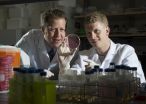Learning is not a spectator sport
Students learn 6 times more with CMU's Simon Initiative approach than with MOOCs
2015-09-14
(Press-News.org) Free - or very inexpensive - online courses have become quite a trend in education. Massive Open Online Course (MOOC) providers currently offer thousands of courses and have enticed millions of students to enroll. The emphasis in MOOCs is often on lecture videos that students watch and learn from.
However, a study published in the Proceedings of the Second (2015) ACM Conference on Learning @ Scale shows that this central approach of MOOCs - having students watch to learn - is ineffective. Instead, the emphasis on interactive activities as advocated by Carnegie Mellon University's Simon Initiative helps students learn about six times more.
CMU's Simon Initiative, named for the late Nobel and Turning laureate Herbert Simon, aims to measurably improve student learning outcomes by harnessing a learning engineering ecosystem that has developed over several decades at CMU. The Simon Initiative approach uses CMU's Open Learning Initiative (OLI) courses, which are built to mimic intelligent tutors in order to provide adaptive feedback and hints during learning by doing.
"Learning by doing gives students deliberative practice opportunities to address a course's objectives," said Ken Koedinger, professor of human-computer interaction and psychology and co-coordinator of the Simon Initiative. "With OLI, students get immediate feedback. If they do not master a concept, they have to go back to re-watch or re-read and then demonstrate they have learned before they are able to move on."
Koedinger and his team set out to understand the difference between MOOCs and OLI courses, specifically whether OLI features help students learn more than MOOC lecture videos. They compared two uses of an Introduction to Psychology as a Science class: 18,645 students took it as a MOOC only, while 9,075 enrolled in it as a combined MOOC and OLI course. Eleven weekly quizzes and a final exam were given to all students.
First, the researchers compared how each group's students performed on the final exam. MOOC-only students had an average score of 57 percent, and the MOOC and OLI students averaged 66 percent. This significant difference remains after adjusting for other contributors to student success including their prior educational background and their incoming psychology knowledge.
"Do students learn more with OLI? The answer is a clear and resounding 'yes,'" Koedinger said.
Then, the team investigated how different patterns of student use corresponded with different student learning outcomes. They found that while more watching, reading and doing all predict better learning outcomes, the amount of learning associated with each activity done was six times greater than for each video watched or page read.
"Most of MOOCs' attention has been on scaling teaching - making lectures available to more people," said Norman Bier, director of OLI and executive director of the Simon Initiative. "This study shows that students can be better served if educators and course creators focus on what we can scale - learning. More attention needs to be placed on designing, developing and improving the learning experience in online courses - with a focus on learning by doing that is well-aligned with outcomes and assessments."
Because MOOCs have a history of retention problems, the researchers also compared course dropout and completion rates. They found that MOOC and OLI students were 30% more likely to finish the course and take the final exam than those in the MOOC-only class. Also, participation in the weekly quizzes - meaning students stayed in the courses longer - was always higher for the MOOC and OLI students.
INFORMATION:
In addition to Koedinger and Bier, the CMU research team included Jihee Jim, Julianna Zhuxin Jia, and Elizabeth A. McLaughlin.
The Bill and Melinda Gates Foundation funded the courses' development and delivery. CMU's LearnLab, a Science of Learning Center funded by the National Science Foundation, supported data storage and analytics.
ELSE PRESS RELEASES FROM THIS DATE:
2015-09-14
KINGSTON - New research out of Queen's University has found evidence of emotional load sharing between partners in a close relationship. The study, co-authored by PhD candidate Jessica Lougheed, found that a strong relationship with a loved one can help ease stress when placed in difficult situations.
"We wanted to test a new evolutionary theory in psychology called Social Baseline Theory which suggests that humans adapted to be close to other humans," says Ms. Lougheed. "The idea is that individuals function at a relative deficit when they are farther away from people ...
2015-09-14
This news release is available in Spanish.
The plants on the highest mountain in Ecuador have migrated more than 500 meters to higher altitudes during the last two centuries. This is determined in a new study, in which Aarhus University researchers compared Humboldt's data from 1802 with current conditions.
Although most of the world's species diversity is found in tropical areas, there are very few studies that have examined whether tropical mountain species are affected by climate change to the same extent as temperate species. A new study has now determined ...
2015-09-14
A recently identified molecule produced by skeletal muscle in response to exercise, has been shown to increase bone mass, according to a collaborative study between researchers at the Mount Sinai Bone Program, Icahn School of Medicine at Mount Sinai, the Department of Experimental and Clinical Medicine at University of Ancona in Italy, and the Department of Basic Medical Science, Neuroscience and Sense Organs at the University of Bari in Italy, and published online today in the Proceedings of the National Academy of Sciences (PNAS).
Although exercise is a well known ...
2015-09-14
People with congenital stationary night blindness, or CSNB, have normal vision during the day but find it difficult or impossible to distinguish objects in low light. This rare condition is present from birth and can seriously impact quality of life, especially in locations and conditions where artificial illumination is not available.
Working in collaboration with Japanese scientists, researchers at the University of Pennsylvania have for the first time found a form of CSNB in dogs. Their discovery and subsequent hunt for the genetic mutation responsible may one day ...
2015-09-14
A new study from the Gladstone Institutes shows for the first time that impairments in mitochondria--the brain's cellular power plants--can deplete cellular energy levels and cause neuronal dysfunction in a model of neurodegenerative disease.
A link between mitochondria, energy failure, and neurodegeneration has long been hypothesized. However, no previous studies were able to comprehensively investigate the connection because sufficiently sensitive tests, or assays, were not available to measure ATP (the energy unit of the cell that is generated by mitochondria) in individual ...
2015-09-14
WASHINGTON (Sept. 14, 2015) -- According to initial results of a multi-site landmark study, led by Dominic Raj, M.D., at the George Washington University (GW) site, cardiovascular disease morbidity is significantly reduced through intensive management of high blood pressure.
By targeting a blood pressure of 120 millimeters of mercury (mm Hg), lower than current guidelines, researchers found that adults 50 years and older also significantly reduced their rates of cardiovascular disease and cardiovascular events, such as heart attack and heart failure, as well as stroke, ...
2015-09-14
Humans are extremely choosy when it comes to mating, only settling down and having kids after a long screening process involving nervous flirtations, set-ups by friends, online matchmaking sites, awkward dates, humiliating rejections, hasty retreats and the occasional lucky strike. In the end, we "fall in love" and "live happily ever after." But evolution is an unforgiving force - isn't this choosiness rather a costly waste of time and energy when we should just be "going forth and multiplying?" What, if anything, is the evolutionary point of it all? A new study may have ...
2015-09-14
MRSA is bad news. If you've never heard of it, here's what you need to know: It's pronounced MER-suh, it's a nasty bacterial infection and it can cause serious disease and death.
Senior molecular biology major Jacob Hatch knows MRSA as the infection that took his dad's leg.
Hatch was thousands of miles away on an LDS (Mormon) mission when Methicillin-Resistant Staphylococcus aureus decalcified the bones in his dad's foot and lower leg, leading to an emergency amputation just below the knee.
"It was really hard to hear the news--you never expect to hear someone in ...
2015-09-14
Irvine, Calif., Sept. 14, 2015 -- University of California, Irvine researchers with the School of Medicine have identified the mechanism by which valproic acid controls epileptic seizures, and by doing so, also revealed an underlying factor of seizures.
Valproic acid is widely used to treat various types of seizure disorders, but to this point, the cellular mechanism affected by its anticonvulsant properties were not well understood.
Dr. Naoto Hoshi, an associate professor of pharmacology and physiology & biophysics, and colleagues discovered that valproic acid preserved ...
2015-09-14
Athens, Ga. - Microbiology researchers at the University of Georgia studying a soil bacterium have identified a potential mechanism for neurodegenerative diseases.
A role for the protein HSD10 had been suspected in patients with Alzheimer's disease and Parkinson's disease, but no direct connection had previously been established. This new breakthrough suggests that HSD10 reduces oxidative stress, promotes cell repair and prevents cellular death.
The authors first discovered that an enzyme related to HSD10, CsgA, produces energy during sporulation in the bacterium ...
LAST 30 PRESS RELEASES:
[Press-News.org] Learning is not a spectator sport
Students learn 6 times more with CMU's Simon Initiative approach than with MOOCs


